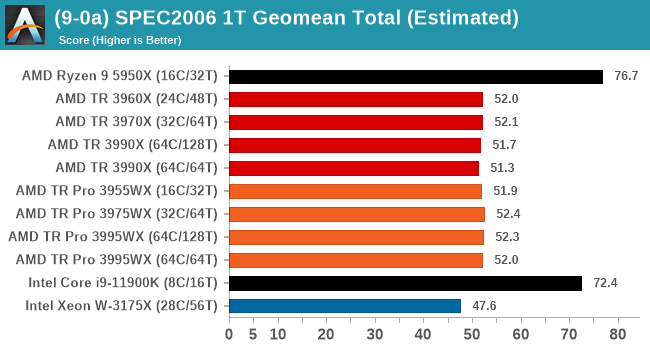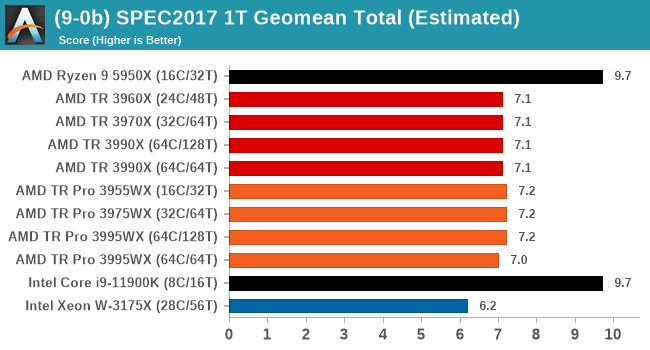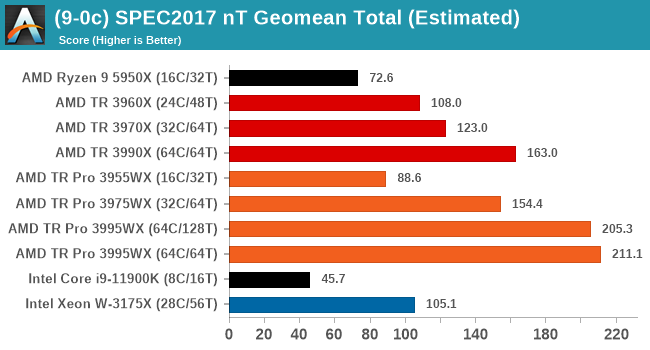AMD Threadripper Pro Review: An Upgrade Over Regular Threadripper?
by Dr. Ian Cutress on July 14, 2021 9:00 AM EST- Posted in
- CPUs
- AMD
- ThreadRipper
- Threadripper Pro
- 3995WX
CPU Tests: SPEC
SPEC2017 and SPEC2006 is a series of standardized tests used to probe the overall performance between different systems, different architectures, different microarchitectures, and setups. The code has to be compiled, and then the results can be submitted to an online database for comparison. It covers a range of integer and floating point workloads, and can be very optimized for each CPU, so it is important to check how the benchmarks are being compiled and run.
We run the tests in a harness built through Windows Subsystem for Linux, developed by our own Andrei Frumusanu. WSL has some odd quirks, with one test not running due to a WSL fixed stack size, but for like-for-like testing is good enough. SPEC2006 is deprecated in favor of 2017, but remains an interesting comparison point in our data. Because our scores aren’t official submissions, as per SPEC guidelines we have to declare them as internal estimates from our part.
For compilers, we use LLVM both for C/C++ and Fortan tests, and for Fortran we’re using the Flang compiler. The rationale of using LLVM over GCC is better cross-platform comparisons to platforms that have only have LLVM support and future articles where we’ll investigate this aspect more. We’re not considering closed-sourced compilers such as MSVC or ICC.
clang version 10.0.0-svn350067-1~exp1+0~20181226174230.701~1.gbp6019f2 (trunk)
-Ofast -fomit-frame-pointer
-march=x86-64
-mtune=core-avx2
-mfma -mavx -mavx2
Our compiler flags are straightforward, with basic –Ofast and relevant ISA switches to allow for AVX2 instructions. We decided to build our SPEC binaries on AVX2, which puts a limit on Haswell as how old we can go before the testing will fall over. This also means we don’t have AVX512 binaries, primarily because in order to get the best performance, the AVX-512 intrinsic should be packed by a proper expert, as with our AVX-512 benchmark. All of the major vendors, AMD, Intel, and Arm, all support the way in which we are testing SPEC.
To note, the requirements for the SPEC licence state that any benchmark results from SPEC have to be labelled ‘estimated’ until they are verified on the SPEC website as a meaningful representation of the expected performance. This is most often done by the big companies and OEMs to showcase performance to customers, however is quite over the top for what we do as reviewers.
For each of the SPEC targets we are doing, SPEC2006 rate-1, SPEC2017 rate-1, and SPEC2017 rate-N, rather than publish all the separate test data in our reviews, we are going to condense it down into a few interesting data points. The full per-test values are in our benchmark database.


Single thread is very much what we expected, with the consumer processors out in the lead and no real major differences between TR and TR Pro.

That changes when we move into full thread mode. The extra bandwidth of TR Pro is clear to see, even in the 32C/64T model. In this test we're using 128 GB of memory for all TR and TR Pro processors, and we're seeing a small bump when in 64C/64T mode, perhaps due to the increased memory cap/thread and memory bandwidth/thread as well. The 3990X 64C/128T run kept failing for an odd reason, so we do not have a score for that test.










98 Comments
View All Comments
Threska - Tuesday, July 20, 2021 - link
VFIO would be more popular if video card makers weren't tight with GPU-pasthrough.https://forum.level1techs.com/t/the-vfio-and-gpu-p...
CPUs like Threadripper would be a great fit.
FLORIDAMAN85 - Wednesday, July 21, 2021 - link
Alt title: AMD, faster than Intel in Crysis, again.quadibloc - Thursday, July 22, 2021 - link
It's too bad it took so long for this chip to become generally available. I hope this won't be repeated in the next generation of Threadrippers - and they should have become available sooner. Like within a month of Ryzen, so that people could buy them before they're already obsolete.mode_13h - Thursday, July 22, 2021 - link
> Like within a month of Ryzen, so that people could buy them before they're already obsolete.First, how is it obsolete? TR 3000 and TR 3000 Pro are still peerless, in many ways.
Second, Intel has traditionally had like 6 months or a year of lag between their mainstream and HEDT. I know you didn't say anything about Intel, but I'm pointing this out because it establishes a precedent for what AMD is doing (not that I think AMD is worried about precedents).
alpha754293 - Thursday, July 29, 2021 - link
"file:///J:/Shared%20drives/AnandTech/Articles/20210706%20TR%20Pro/AMD%20Opens%20Up%20Threadripper%20Pro:%20Three%20New%20WRX80%20Motherboards"You might want to fix this link in your review.
Ryan Smith - Monday, August 2, 2021 - link
Thanks!0ldman79 - Thursday, July 29, 2021 - link
I can understand Lenovo locking their OEM CPUs to their motherboards as a packaged deal.If I read this correctly, ALL Threadripper Pro CPUs will be locked to Lenovo boards forever if they're ever installed in a Lenovo P620 motherboard.
That's a huge load of crap. No one is going to know this except for Anandtech readers and whatever poor schmuck that gets screwed a few years down the road.
Hopefully someone will figure out how to defeat that OEM lock. That is just poor judgment on AMD's part.
To clarify, I have zero problem with the CPU being locked to the Lenovo system *as it is sold*, but it is 100% unacceptable to lock a LATER installed CPU to the motherboard as well.
GregoriaEgan - Sunday, December 12, 2021 - link
So I was thinking about getting the low end 3955WX Threadripper Pro, but as I understand it the 24 Core "old" Threadripper are better because of more chiplets (and cores). I just saw a mentioning of TH "Pro" functions, I'm unsure, are there more functions of the Pro-line, like remote administration or the like?I doubt that I would ever get more than 256 GB RAM and I'm not sure that I need the extra PCI-e lanes, but are there any other more features that just don't exist in the non-pro TH, that you only get with the Pro-line?